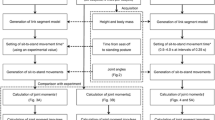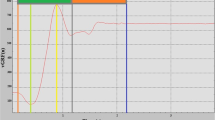Abstract
This study examined the influence of various loads to the lower limbs and the characteristics of sit-to-stand (STS) movement. Four relative loads (0%, 10%, 20%, or 30% of a subject's body mass) were distributed and attached to each subject. Thirty percent body mass (BM) was the maximal load under which subjects could complete STS movements. First, body variance of STS movement was examined by three-dimensional motion analyses. Anteroposterior effects of the load differences were observed, while horizontal and vertical effects were not. Next, the relationships between anteroposterior variance of STS movement, ground reaction force and EMG were examined. The influence of load differences on knocking over force, quickness of movement, work volume, and characteristics of muscle activity in each movement phase was observed, with the most noticeable differences occurring at 0% and 30% BM. With increased load, the knocking over force weakened, movement slowed, lower limb joints angles enlarged, and instability increased. A similar phenomenon may occur when BM increases despite the same muscle function of the lower limbs and when muscle function decreases despite the same BM. Elderly with a marked decrease in nervous and muscle functions of the lower limbs may have more unstable STS movement.
Similar content being viewed by others
Author information
Authors and Affiliations
Corresponding author
Rights and permissions
About this article
Cite this article
Yamada, T., Demura, S. Influence of load burdens on lower limbs in each movement phase and the characteristics of sit-to-stand movement. Sport Sci Health 2, 8–15 (2007). https://doi.org/10.1007/s11332-007-0032-4
Received:
Accepted:
Issue Date:
DOI: https://doi.org/10.1007/s11332-007-0032-4




